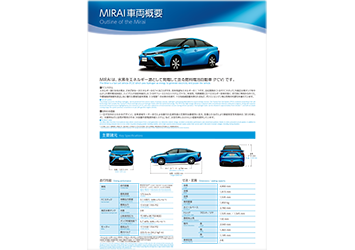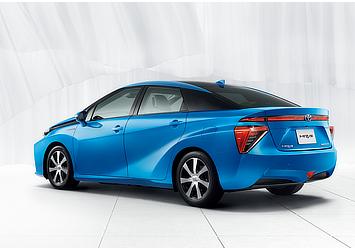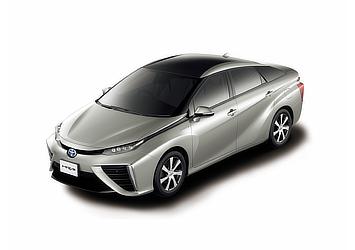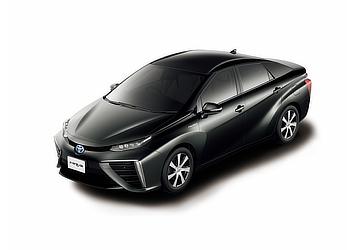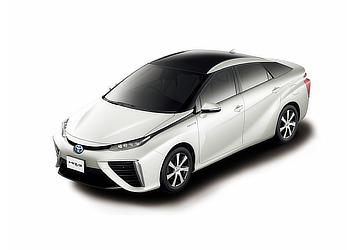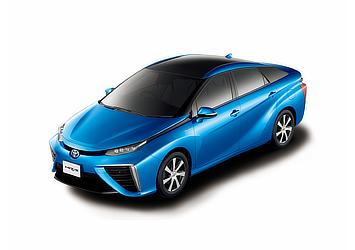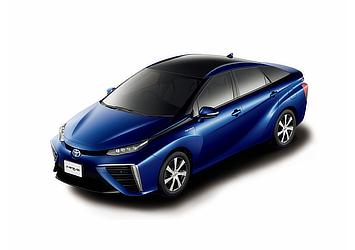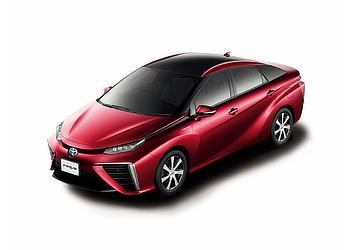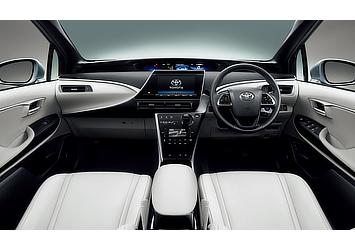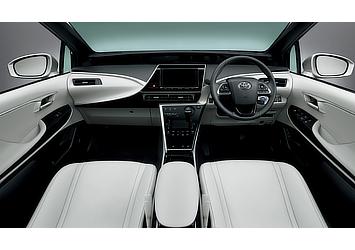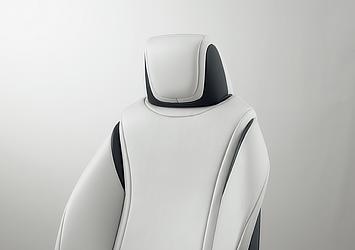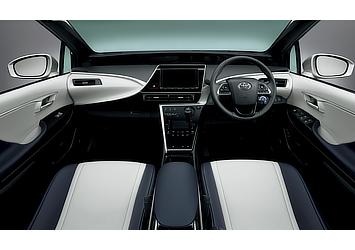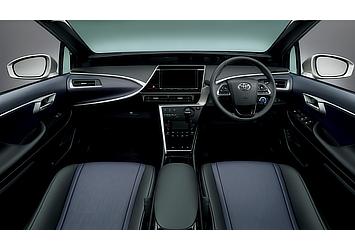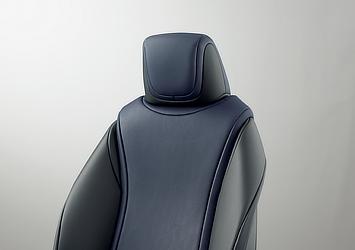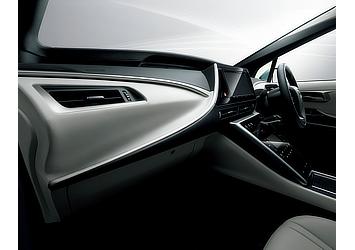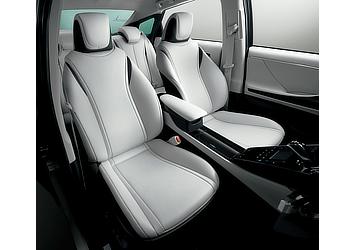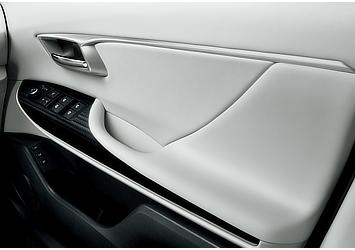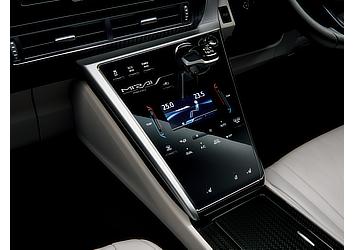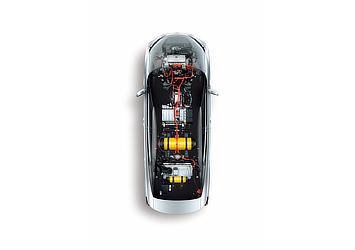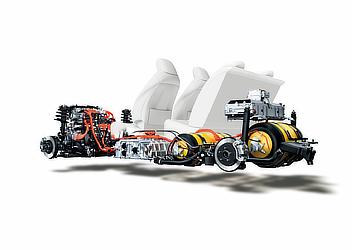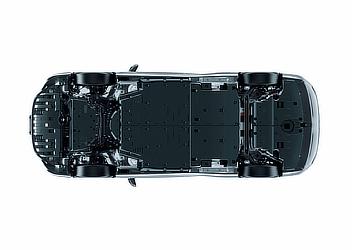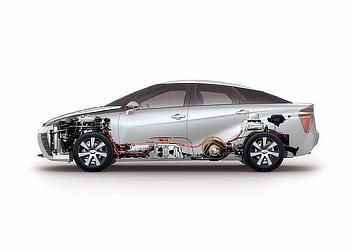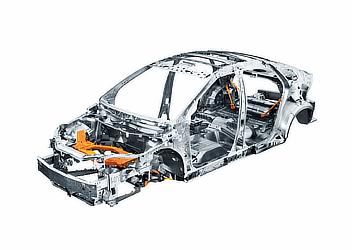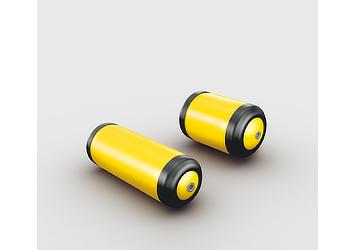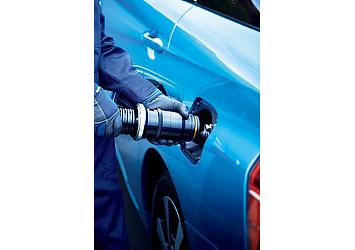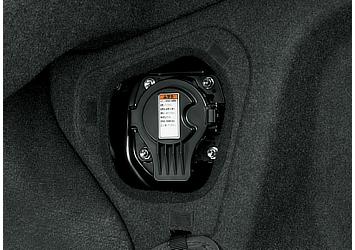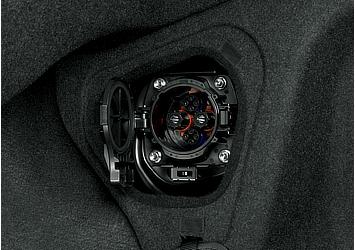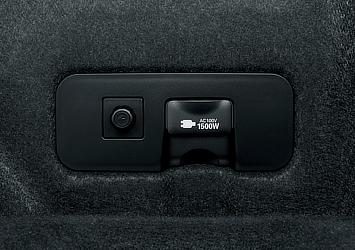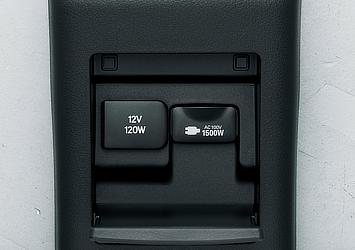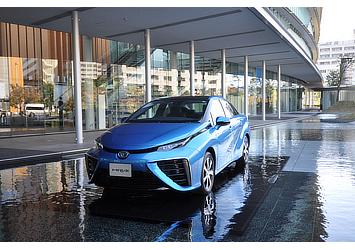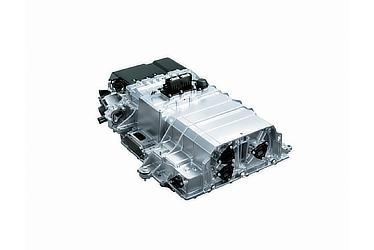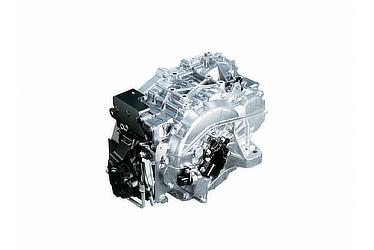Nov. 18, 2014
Toyota Ushers in the Future with Launch of 'Mirai' Fuel Cell Sedan
Toyota City, Japan, November 18, 2014―Toyota Motor Corporation will launch its all-new "Mirai"1 hydrogen fuel cell vehicle (FCV) in Japan on December 15. The vehicle will be sold through "Toyota"2 and "Toyopet"2 dealers.
The Mirai signals the start of a new age of vehicles. Using hydrogen―an important future energy source―as fuel to generate electricity, the Mirai achieves superior environmental performance with the convenience and driving pleasure expected of any car.

Mirai
The Mirai uses the Toyota Fuel Cell System (TFCS), which features both fuel cell technology and hybrid technology, and includes Toyota's new proprietary FC Stack and high-pressure hydrogen tanks. The TFCS is more energy efficient than internal combustion engines and emits no CO2 or substances of concern (SOCs) when driven. Drivers can also expect the same level of convenience as offered by gasoline engine vehicles, with a generous cruising range and a hydrogen refueling time of about three minutes3.
The Mirai delivers everything expected of a next-generation car: an immediately recognizable design; driving exhilaration stemming from superior handling stability achieved by a low center of gravity; and quiet but powerful acceleration provided by the electric motor. The Mirai also features an exclusive telematics service for a safe, secure and comfortable ride, and the vehicle can double as a high-capacity external power supply system during power outages, disasters and other emergencies.
Hydrogen can be generated using a wide range of natural resources and man-made byproducts such as sewage sludge. It can also be created from water using natural renewable energy sources like solar and wind power. When compressed, it has a higher energy density than batteries, and is relatively easy to store and transport, therefore it also carries expectations for potential future use in power generation and a wide range of other applications. FCVs are able to generate their own electricity from hydrogen, meaning they can help make a future hydrogen-based society a reality, and are therefore expected to further contribute to accelerating energy diversification.
Sales Outline
Start of sales: December 15, 2014
Sales channels: "Toyota" and "Toyopet" dealerships
Sales target: Approximately 400 units in Japan by the end of 2015
Manufacturer's Suggested Retail Price: 7,236,000 yen (Includes consumption tax; does not include recycling fees; differs in Hokkaido and Okinawa)
Production Plant
Motomachi Plant, Toyota Motor Corporation
Vehicle Outline
1. TFCS provides superior environmental performance and convenience
The Mirai features the TFCS, a fusion of fuel cell technology with hybrid technology.
The system provides better energy efficiency than internal combustion engines, superior environmental performance with no emissions of CO2 or SOCs when driving, and the same level of convenience as gasoline engine vehicles with a cruising range4 of 650 km (according to Toyota measurements taken based on the Japanese Ministry of Land, Infrastructure, Transport and Tourism's JC08 test cycle) and a hydrogen refueling time of about three minutes3.
The system uses Toyota-developed components including the Toyota FC Stack, FC boost converter, and high-pressure hydrogen tanks.
Toyota FC Stack
The new Toyota FC Stack achieves a maximum output of 114 kW. Electricity generation efficiency has been enhanced through the use of 3D fine mesh flow channels5 (a world first6), which ensure uniform generation of electricity on cell surfaces, providing compact size and a high level of performance, and a world-leading6 power output density of 3.1 kW/L (2.2 times higher than that of the previous Toyota FCHV-adv limited-lease model).
The amount of water on fuel cell electrolyte membranes has a substantial influence on electricity generation efficiency. Control of the amount of water is carried out using an internal circulation system for circulating the water created when generating electricity, meaning the Toyota FC Stack is a world-leading6 system that, unlike systems used in all other previous Toyota fuel cell vehicles, does not require the use of a humidifier.
FC Boost Converter
A new compact, high-efficiency, high-capacity converter has been developed to boost power generated in the Toyota FC Stack to 650 volts. Increasing the voltage has made it possible to reduce the size of the electric motor and the number of Toyota FC Stack fuel cells, leading to a smaller, higher-performance Toyota Fuel Cell System, thereby reducing system costs.
High-pressure Hydrogen Tanks
Tanks with a three-layer structure made of carbon fiber-reinforced plastic and other materials are used to store hydrogen at a very high pressure of 70 MPa (70 megapascals, or approximately 700 bars). Compared to the high pressure hydrogen tanks used in the Toyota FCHV-adv model, tank storage has been increased by approximately 20 percent while both weight and size have been reduced to achieve a world-leading6 5.7 wt%7.
Key Toyota Fuel Cell System (TFCS) Specifications
| FC stack | Name | Toyota FC Stack |
|---|---|---|
| Type | Polymer electrolyte fuel cell | |
| Volume power density | 3.1 kW/L | |
| Maximum output | 114 kW (155 PS) | |
| Humidification system | Internal circulation (humidifier-less) | |
| High-pressure hydrogen tank | Number of tanks | 2 |
| Nominal working pressure | 70 MPa (approx. 700 bar) | |
| Tank storage density | 5.7 wt% | |
| Tank internal volume | 122.4 liters (front tank: 60.0 liters; rear tank: 62.4 liters) | |
| Motor | Type | AC synchronous electric generator |
| Maximum output | 113 kW (154 PS) | |
| Maximum torque | 335 N-m (34.2 kgf-m) | |
| Battery | Type | Nickel-metal hydride |
2. Safe and secure vehicle design with comprehensive range of safety features
FCV safety measures
The Mirai was designed with safety as a top priority, based on the basic approach of ensuring that hydrogen does not leak, and in the unlikely event that any leaks do occur, ensuring immediate detection and stoppage of hydrogen flow and preventing accumulation of hydrogen within the car body.
- Development of high pressure hydrogen tanks with excellent hydrogen permeation prevention performance, strength, and durability
- Hydrogen sensors provide warnings and can shut off tank main stop valves
- Hydrogen tanks and other hydrogen-related parts are located outside the cabin to ensure that if hydrogen leaks, it will dissipate easily
Use of features such as a structure that efficiently disperses and absorbs impact energy across multiple parts ensures a high impact safety performance that protects the Toyota FC Stack and high-pressure hydrogen tanks during frontal, side or rear impacts.
The Toyota FC Stack frame is constructed from a newly-developed thermoplastic carbon fiber-reinforced plastic, which is light, strong, and easily mass-produced. This protects the Toyota FC Stack by absorbing impact shocks from road bumps and other road interference.
A full range of advanced safety equipment appropriate for next-generation vehicles
- Standard inclusion of advanced safety technologies
- A Pre-collision System (with millimeter-wave radar) helps prevent collisions or reduce collision damage through alerts and brake control if a high likelihood of collision is detected.
- A Lane Departure Alert system uses a camera to detect white or yellow lane markings and alerts the driver when the vehicle is about to deviate from its lane.
- Drive-start Control limits sudden starts or sudden acceleration during gear-shift operation.
- A Blind Spot Monitor uses radar to detect vehicles in adjacent lanes and helps rear view confirmation when changing lanes.
Mirai's connective services contribute to safer driving
The T-Connect Data Communication Module (DCM) package comes with additional exclusive support functionality8 to ensure a safe, secure and comfortable ride.
- The "Hydrogen Station List" a specialized app9 service, uses the navigation system screen to display information and current operation status of the three closest hydrogen stations based on the location of the car.
- "Pocket Mirai", an exclusive smartphone application, displays information and current operation status of hydrogen stations nationwide, the vehicle's remaining hydrogen fuel, possible cruising distance, and possible external power supply time. It also includes a hydrogen refueling record function and a game function that enhances driving pleasure.
- The FC system remote monitoring service displays a warning notification on the navigation system screen if it detects a system abnormality, and also includes a remote diagnostics support system that allows the vehicle to be checked from a terminal at the dealer and the driver to be given appropriate advice if the dealer is contacted by the driver.
3. Mirai's immediately recognizable design
Exterior
A new technique has been employed in the front face design to emphasize the left and right grilles that draw in air for the oxygen supply and for FC system cooling. The novel front face underscores the vehicle's individuality.
The elegant side profile evokes the flowing shape of a droplet of water to express the vehicle's characteristic of drawing in air and emitting water. The roof-side rails and hood appear to pop out of the body to create the impression of a low-to-the-ground vehicle while communicating a futuristic feeling.
The rear of the vehicle presents a bold profile with a trapezoidal shape extending from the license plate garnish to the bottom of the bumper corners and out toward the wheels, while the top of the bumper emphasizes width and expresses a powerfully stable stance. It also creates an agile and clean impression of air passing through and under the bumper.
The headlights exhibit high-tech and sophisticated luxury through a novel design that presents an ultra-thin profile with an inline arrangement of four LED lights plus visible heat sinks and other optical equipment. The front turn signals and clearance lights are separate from the headlights, contributing to an ultra-thin headlight profile at the same time as merging with the side grilles. This creates an advanced clean design with aerodynamics that improve airflow.
The Mirai comes with 17-inch aluminum wheels that have been made lighter using an engraving process10.
Six body colors are available, including the new two-tone Pure Blue Metallic11.
Interior
The Mirai's profile connects the front and rear in a seamlessly pleasant expression of space. It creates a sophisticated cabin space with soft padding on door trims and other interior surfaces, and a high-luminance silver finish throughout.
The front seats provide superior body fit and hold through an integrated cover/seat foaming production process12. Eight-way adjustable power seats for achieving the optimal seat position and a motorized lumbar support function are installed as standard on the driver's and passenger's seats.
The center meter cluster located in the central top level of the instrument panel includes a speedometer and multi-information display using a 4.2-inch high-definition TFT liquid crystal display with a design that appears to pop out. The driver is able to change the display using steering-wheel-mounted controls.
Seat heater switches and other controls are operated via an electrostatic air conditioning control panel by lightly touching the flat panel display.
Functions that provide a comfortable interior space come as standard, such as a steering wheel heater and seat heaters (two temperature settings on all seats) that provide instant heat while greatly reducing power consumption, fully automatic left and right independent temperature control air conditioning with eco mode switches, and "Nanoe"13 air purification technology to fill the cabin with fresh air.
Three interior colors are available, including Warm White.
Package
Battery layout enables abundant trunk storage space.
4. Superior handling stability and outstanding quietness enhances driving pleasure
The high output Toyota FC Stack and optimal battery power control drive the electric motor and ensure powerful responsiveness at all vehicle speeds. This provides an immediate increase in torque at the first press of the accelerator, and powerful and smooth acceleration thereafter.
Handling stability and ride comfort are both improved through the location of major parts such as the Toyota FC Stack and high pressure hydrogen tanks centrally under the floor to achieve a low center of gravity and superior front-and-rear weight distribution, as well as the use of a high-rigidity body, which features enhanced rigidity around the rear suspension.
The full under-floor cover and aerodynamically designed clearance lights reduce wind resistance and contribute to improved fuel efficiency and handling stability. Aero fins employed at the side of the rear combination lamps also improve straight-driving stability.
Outstanding quietness is achieved by electric motor drive at all speeds and reduced wind noise, plus full sealing of all body parts, and the use of sound-absorbing and sound-blocking materials optimally arranged around the cabin, including the use of noise-reducing glass for the windshield and all door windows.
Brake support mode makes efficient use of regenerative braking and improves braking performance when the driver wishes to greatly reduce vehicle speed such as when negotiating long downhill sections of road.
5. Large external power supply system
The Mirai comes with a power supply system with a large capacity of approximately 60 kWh14 and maximum power supply capability of 9 kW15 for use during power outages, such as those following natural disasters. When a power supply unit (sold separately) is connected, it converts the DC power from the CHAdeMO power socket located inside the trunk to AC power and can power a vehicle-to-home16 system or a vehicle-to-load system. Consumer electronics can also be connected directly and used from the interior accessory socket (AC 100 V, 1,500 W).
Mirai Main Vehicle Specifications
| Length | 4,890 mm |
|---|---|
| Width | 1,815 mm |
| Height | 1,535 mm |
| Wheel-base | 2,780 mm |
| Track (front/rear) | 1,535/1,545 mm |
| Minimum ground clearance | 130 mm |
| Interior length | 2,040 mm |
| Interior width | 1,465 mm |
| Interior height | 1,185 mm |
| Curb weight | 1,850 kg |
| Seating | 4 |
| 1 | Japanese for future |
|---|---|
| 2 | Sales will begin in areas where hydrogen stations are in place and in surrounding areas. According to the Next Generation Vehicle Promotion Center, the following areas are participating in the primary and secondary hydrogen supply facilities infrastructure assistance program in FY2013 and FY2014 (as of June 30, 2014): Saitama Prefecture, Chiba Prefecture, Tokyo, Kanagawa Prefecture, Yamanashi Prefecture, Aichi Prefecture, Shiga Prefecture, Osaka, Hyogo Prefecture, Yamaguchi Prefecture and Fukuoka Prefecture. |
| 3 | As measured by Toyota when refueling at a hydrogen station supplying hydrogen at a pressure of 70 MPa under the SAEe J2601 Standard conditions (ambient temperature: 20°C, hydrogen tank pressure when fueled: 10 MPa). Time will vary depending on hydrogen fueling pressure and ambient temperature. |
| 4 | As measured by Toyota when refueling at a hydrogen station supplying hydrogen at a pressure of 70 MPa under the SAEe J2601 standard conditions (ambient temperature: 20°C, hydrogen tank pressure when fueled: 10 MPa). Differing amounts of hydrogen will be supplied to the tank if refueling is carried out at hydrogen stations with differing specifications, and the cruising range will therefore also differ accordingly. It is estimated that a cruising range of approximately 700 km can be achieved when fueled under the conditions above at new-standard hydrogen stations scheduled to begin operation from FY2016. Possible cruising range may vary largely due to usage conditions (weather, traffic congestion, etc.) and driving methods (quick starts, air conditioning, etc.). |
| 5 | Channels arranged in a fine three-dimensional lattice structure. Enhances the dispersion of air (oxygen) thereby enabling uniform generation of electricity on cell surfaces. |
| 6 | As of November 2014, according to TMC research. |
| 7 | Hydrogen storage mass per tank weight |
| 8 | Service use is via the T-Connect 9-inch navigation system DCM package for the Mirai, a dealer-installed optional navigation system sold separately, and a separate subscription to the T-Connect DCM package. |
| 9 | A T-Connect service that enables installation of additional applications in the navigation system. |
| 10 | Manufacturing process used to reduce the weight of aluminum wheels. Metal is shaved from the intersecting line between the disk and rim to reduce the weight of each aluminum wheel by approximately 500 grams. |
| 11 | Planned for sale from March 2015 |
| 12 | In the previous process, seat pads were molded separately and then covered. In the foaming process, the seat covers are placed into molds and urethane material is directly inserted into them. |
| 13 | A trademark of Panasonic Electric Works Co. Ltd. |
| 14 | After DC/AC conversion by power supply unit. Power supply capacity varies according to power supply unit conversion efficiency, amount of remaining hydrogen and power consumption. |
| 15 | Possible electric power varies depending on the performance of the power supply unit. The power supply unit cannot supply power higher than its capability. |
| 16 | Requires wiring work at the home |




